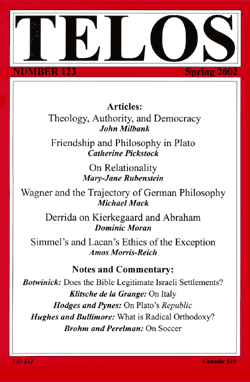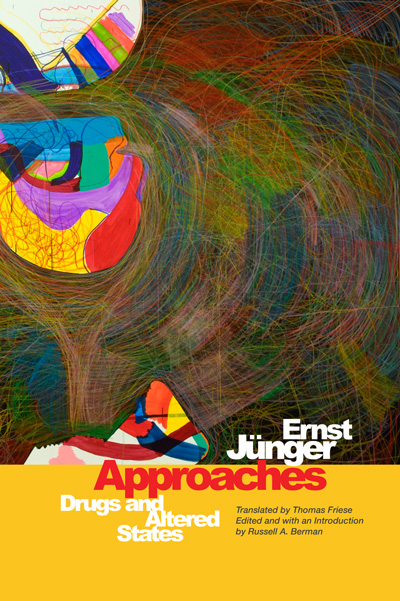As an occasional feature on TELOSscope, we highlight a past Telos article whose critical insights continue to illuminate our thinking and challenge our assumptions. Today, Kyle Nicholas looks at John Hughes and Matthew Bullimore’s “What is Radical Orthodoxy?” from Telos 123 (Spring 2002).
 Mention “Radical Orthodoxy” in a room of people who are either quite intimately or only remotely acquainted with contemporary theology, and one surely will receive equal parts of praise and scorn. Whether it is being praised or scorned, however, it is plain that Radical Orthodoxy has worked its way deep into the fabric of contemporary theological discourse. Since the publication of John Milbank’s Theology and Social Theory in 1992, Catherine Pickstock’s After Writing in 1997, and Radical Orthodoxy: A New Theology, edited by Milbank, Pickstock, and Graham Ward in 1998, the Radical Orthodoxy movement has done what any explosively innovative intellectual movement will do after the hype settles down: mature or wither away.
Mention “Radical Orthodoxy” in a room of people who are either quite intimately or only remotely acquainted with contemporary theology, and one surely will receive equal parts of praise and scorn. Whether it is being praised or scorned, however, it is plain that Radical Orthodoxy has worked its way deep into the fabric of contemporary theological discourse. Since the publication of John Milbank’s Theology and Social Theory in 1992, Catherine Pickstock’s After Writing in 1997, and Radical Orthodoxy: A New Theology, edited by Milbank, Pickstock, and Graham Ward in 1998, the Radical Orthodoxy movement has done what any explosively innovative intellectual movement will do after the hype settles down: mature or wither away.
In their article “What is Radical Orthodoxy?” (Telos 123, Spring 2002), John Hughes and Matthew Bullimore map out, in a short space and yet with crisp detail, the main themes in the Radical Orthodoxy project. For those familiar with the movement, their points will not come as a shock: that a deep metaphysical violence underlies modernity, political liberalism, and capitalism; that the philosophical and theological dualisms of modernity must be named and then overcome with the aid of both premodern and postmodern thought; and that in the face of proliferating violence it is Christian orthodoxy—in line with Aquinas, Boethius, Augustine, Gregory of Nyssa, and Iamblichean Neo-Platonism—that presents truly “radical” alternatives to the prevailing political, philosophical, and theological orders.
Yet more than a decade after Hughes and Bullimore’s article, and two decades after Milbank’s Theology and Social Theory, where can the movement be located, and in what ways has it matured and ingrained itself in contemporary discourse so as to not wither away after its exciting yet brief flair of theological excitement? I propose there are three often-overlooked reasons for its continuing relevance in light of Hughes and Bullimore’s essay.
First, this movement is adaptable enough to have far-reaching consequences. Amidst scathing critiques from every corner, Radical Orthodoxy has continued to bear fruit on both sides of the Atlantic for almost a quarter of a century. This is due to the philosophical depth and engagement of the movement with other areas of thought. Scholars such as Daniel Bell and D. Stephen Long have extended the radically orthodox line of thinking to such areas as liberation theology and economics; Connor Cunningham and Simon Oliver have been active in biology and physics; and most recently Adrian Pabst and William Cavanaugh have mapped contemporary political theory onto the metaphysical genealogy of modernity advanced by Radical Orthodoxy. At the same time, Milbank, Pickstock, and Ward have remained active in the continental philosophy of religion, facilitating discussions between Christian orthodoxy and some of today’s most prominent continental philosophers, including Alain Badiou, Slavoj Žižek, and Giorgio Agamben.
Second, this movement is not a groundless new development in contemporary thought. One of the fiercest and oft-repeated criticisms of Radical Orthodoxy is that its sweeping claims about modernity’s ills have little ground or support. Duns Scotus, many argue, is the whipping boy of the movement, and no critics actually have substantiated the wild claims made against him. Yet Radical Orthodoxy’s perspectives continue to be vindicated by scholars and researchers outside of the movement (and even Christianity) in some of its most fundamental claims.
Recognizing that Scotus and Ockham are the main precursors to philosophical and political modernity, we can name several other significant scholars that have come to reaffirm basic tenets of this claim largely independent of Radical Orthodoxy, e.g., Rémi Brague, Olivier Boulnois, André de Muralt, Ludger Honnefelder, and Michael Allen Gillespie. Even for those influenced by the movement, considerable care and analytical precision has been taken to reassert these claims, like Adrian Pabst’s meticulous 2012 book Metaphysics: The Creation of Hierarchy. Additionally, it was in 1985, seven years before Theology and Social Theory, that André de Muralt published “Kant, le dernier occamien” in his book La Metaphysique du Phenomene, tracing Kant’s philosophical modernity back to Ockham’s nominalist separation of form and matter. John Hughes himself, in his 2007 book The End of Work, brilliantly shows that the movement is not “nostalgic.” Instead, it finds modern philosophical and aesthetic parallels in the Romantic movement and modern economic examples of its insights in various non-statist, Christian socialist projects. The claims of Muralt, Hughes, and various other scholars listed above, which further contextualize many of the same claims made by Milbank and Pickstock, may be controversial, but they have not proven to be as “irresponsible,” “groundless,” or “novel,” as opponents—especially many American opponents—have accused Radical Orthodoxy of being.
Finally, the movement is self-critical. Milbank has said that when he began his theological career, he was very individualistic in his work, which denounces individualism. Now, he sees not just the value but also the necessity of being collaborative in theological and philosophical pursuits. Part of the danger of being collaborative, as Radical Orthodoxy has increasingly become, is the necessity of being open to self-criticism if the collaboration will advance in any meaningful ways. Of course, this stands opposed to another argument leveled against the movement: that it bears a certain unteachable obstinacy that has an insulating effect, rendering it free to give blame but not to take it.
And yet the movement has proven itself as capable of self-criticism, and it only appears insulated to those who do not engage it in its full breadth and complexity. For example, one of the most stringent critiques of Radical Orthodoxy is Cyril O’Regan’s concluding lecture of his Taylor lectures at Yale Divinity School in 2014. Nonetheless, his sharp critique helps to illustrate the paradox that often those with the most helpful critiques of Radical Orthodoxy share many of the same interests and emphases as the movement. Indeed, since O’Regan has the theological and philosophical rigor that few others equal, he is able to helpfully critique the movement with more than just name-calling and ad hominen attacks, all the while developing many of his intellectual emphases along with the movement.
Another example might be J. Kameron Carter’s groundbreaking 2008 work Race: A Theological Account. In an endnote in this volume, Carter explains that much of his critique of modernity draws from Milbank, and yet Milbank and his project have single-handedly failed to critique Britain’s own history of oppressive colonialism. Less articulate opponents have simply opted to call Radical Orthodoxy bigoted, elitist, and oppressive. Here again we see the same paradox emerging. In a footnote in his 2013 book Beyond Secular Order, Milbank responds briefly, thoughtfully, and critically to Carter’s accusations and then goes on to recommend Carter’s work.
Through this interplay of expanding critical influence, then, Radical Orthodoxy has matured and spread throughout contemporary theological and political discourse, marking itself as an intellectual movement open to many voices in different areas of thought rather than as a homogenous insular group of like-minded individuals. In addition, the Radical Orthodoxy book series has evolved and branched out into more established and institutionalized venues: the Centre of Theology and Philosophy at Nottingham, the Veritas, Illuminations, and Interventions book lines, the Radical Orthodoxy: Theology, Philosophy, Politics (RO:TPP) peer-reviewed journal, yearly meetings, and even the Blue Labour movement of Maurice Glasman and Adrian Pabst in English politics.
Radical Orthodoxy as an exciting position to profess or denounce has withered away, for good or for ill, and professors and graduate students should stop tossing it about as if its effects were a singular position. Instead, Radical Orthodoxy, as a way of speaking and thinking, continues to spread as its views are being reaffirmed, challenged, and expanded upon throughout the West and beyond, from theology at Duke Divinity School to the natural sciences at Cambridge to economics in Italy. Since Radical Orthodoxy has become not a position to take against other positions, but a fruitful and convincing language with which to debate and discuss any position, Radical Orthodoxy may well be entering its most promising and fruitful stage yet.




Very interesting piece. One quick note:
“Additionally, it was in 1985, seven years before Theology and Social Theory, that André de Muralt published “Kant, le dernier occamien” in his book La Metaphysique du Phenomene, tracing Kant’s philosophical modernity back to Ockham’s nominalist separation of form and matter.”
This was originally published in 1975 as an article in Revue de Métaphysique et de Morale 80 (1):32 – 53.
Thanks for this note; I had only come across it in his book. Good to know!